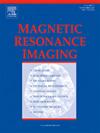MEMRI-based functional mapping of the visual system in response to color stimuli
IF 2
4区 医学
Q2 RADIOLOGY, NUCLEAR MEDICINE & MEDICAL IMAGING
引用次数: 0
Abstract
Background
Manganese-enhanced MRI (MEMRI) visualizes neuronal activity via manganese uptake. While intravitreal MnCl₂ injection is effective, it is invasive and carries toxicity risks. This study aimed to evaluate a noninvasive topical MnCl₂ approach for detecting functional activation in the rat visual pathway in response to color-specific light stimuli.
Methods
Sprague–Dawley rats (N = 24) were randomly assigned to red, green, blue, or dark-exposed control groups (n = 6 per group). Each animal received 5 μL of 0.1 M MnCl₂ topically to the right eye, followed by 10 h of exposure to monochromatic LED light or darkness. T1-weighted MRI was performed on a 1.5-T scanner. Image processing included region-of-interest (ROI) analysis and voxel-wise statistical parametric mapping (SPM) using AlphaSim-based cluster correction (voxel-wise p < 0.005, minimum cluster size = 16 voxels).
Results
MEMRI signal enhancement was observed in the retina, optic nerve, and superior colliculus in the green light group only. ROI analysis showed a significant increase in signal-to-noise ratio (SNR) for green light, and to a lesser extent for blue light, compared to control (p < 0.05), while red light elicited no significant changes. SPM analysis confirmed localized signal enhancement in the contralateral postchiasmatic optic tract and superior colliculus in the green light group.
Conclusion
Topical MnCl₂ combined with MEMRI successfully detected color-dependent neuronal activation in the rat visual system. These findings support the utility of noninvasive MEMRI combined with color stimulation and voxel-wise analysis as a promising tool for functional mapping of the sensory pathways.
基于memri的视觉系统对颜色刺激反应的功能映射
背景:锰增强MRI (MEMRI)通过锰摄取来显示神经元活动。虽然玻璃体内注射MnCl 2是有效的,但它是侵入性的,并且有毒性风险。本研究旨在评估一种非侵入性外用MnCl 2方法,用于检测大鼠视觉通路对颜色特异性光刺激的功能激活。方法sd - dawley大鼠24只,随机分为红色、绿色、蓝色、黑暗暴露组(每组6只)。每只动物的右眼局部注射5 μL 0.1 M MnCl 2,然后在单色LED光或黑暗中暴露10小时。t1加权MRI在1.5 t扫描仪上进行。图像处理包括感兴趣区域(ROI)分析和使用基于alphasim的聚类校正的体素统计参数映射(SPM)。0.005,最小簇大小= 16体素)。结果仅绿光组视网膜、视神经和上丘的smmri信号增强。ROI分析显示,与对照组相比,绿光的信噪比(SNR)显著增加,蓝光的信噪比(SNR)的增加程度较小(p <;0.05),而红光无显著变化。SPM分析证实,绿光组对侧视交叉后束和上丘局部信号增强。结论外用MnCl 2联合MEMRI成功检测了大鼠视觉系统中颜色依赖性神经元的激活。这些发现支持了非侵入性MEMRI结合颜色刺激和体素分析作为一种有前途的感觉通路功能映射工具的实用性。
本文章由计算机程序翻译,如有差异,请以英文原文为准。
求助全文
约1分钟内获得全文
求助全文
来源期刊

Magnetic resonance imaging
医学-核医学
CiteScore
4.70
自引率
4.00%
发文量
194
审稿时长
83 days
期刊介绍:
Magnetic Resonance Imaging (MRI) is the first international multidisciplinary journal encompassing physical, life, and clinical science investigations as they relate to the development and use of magnetic resonance imaging. MRI is dedicated to both basic research, technological innovation and applications, providing a single forum for communication among radiologists, physicists, chemists, biochemists, biologists, engineers, internists, pathologists, physiologists, computer scientists, and mathematicians.
 求助内容:
求助内容: 应助结果提醒方式:
应助结果提醒方式:


